About Jason Morgan
My love of animals has been there for as long as I can remember, along with my desire to draw and paint, so looking back it now seems inevitable that I would become a Professional wildlife artist
I strive to paint wildlife as accurately as I can, so where possible I like to see the animals in their natural environment, and this has, of course, lead to some very exciting journeys and experiences.
It’s these exhilarating and very personal experiences that I believe help me so much in my portrayal of wildlife in it’s natural environment.
It’s the hidden things that you can truly only experience by being there in person.
My Personal Endorsement
I highly recommend that you explore Jason’s websites by following the links below. On his websites you will find more free demonstrations, original paintings, prints and instructional ebooks for sale.
I have known Jason for quite some time now and not only is he an honest, reliable and all around good guy, but he is also an exceptional artist, as you will soon find out by viewing the wildlife demonstration below.
If you are ever in need of Wildlife Art or Wildlife Painting Instruction, I highly recommend you consider Jason as your source. You will not find higher quality or better value anywhere else!
Jason’s Websites:
===> https://www.onlineartdemos.co.uk
===> https://www.jasonmorgan.co.uk/
Mountain Gorilla – Free Demonstration
This large painting will certainly need a plan if I am to do the subject justice. The pencil sketch left shows the important things I have in mind to make the eyes the center of interest.

The first stages are always the same no matter what the subject – get some paint on the whole canvas. I don’t worry too much about the correct colours, but I do always paint in the direction of fur growth, even at this early stage.As per my usual technique a very thin coat of Liquin painting medium was applied to the whole canvas before I began painting in to it whilst it was still wet – this allows the paint to slide more easily.
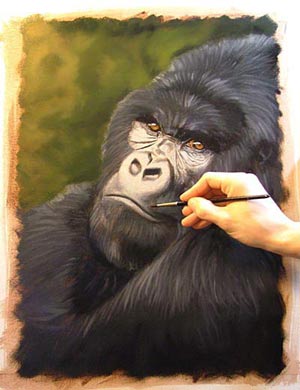
With the first coat blocked in and dry I know paint another thin coat of liquin over the fur area to be painted.I then select one of my old bristle brushes (or age one yourself by rubbing the bristles along glass paper) and dip just the tip into thick oil paint (no liquin) in this instance I used white plus a little ultramarine blue and burnt umber.With a very light touch and flowing strokes I then simulated the first (under-layer) of fur texture.
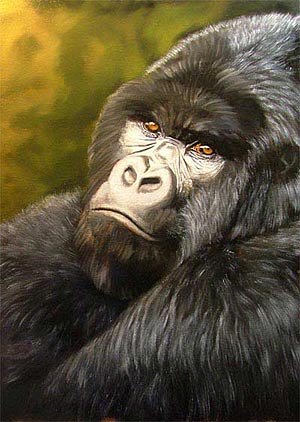
This image shows the whole fur area textured, it is obviously much too light at this stage but it will be knocked back with glazes later.
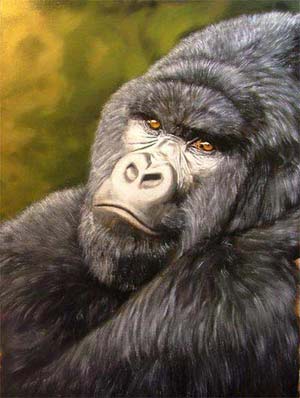
To apply a glaze I once again painted a thin coat of liquin over the fur area, then whilst still wet I glazed a very thin transparent dark over the top.
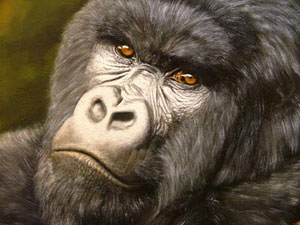
With the underfur knocked back with the glazes in the previous stage (which is now dry) I begin to paint in the fur details (see the shoulder area) this is done following the same technique of liquin then a bristle brush with a little paint on the surface
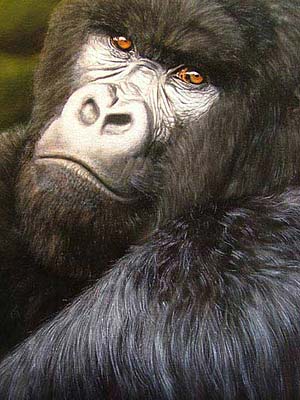
After the second layer of fur texture has been applied and is dry it is then time for more glazes and perhaps another coat of texture in places I feel needs it. I also strengthen the background.
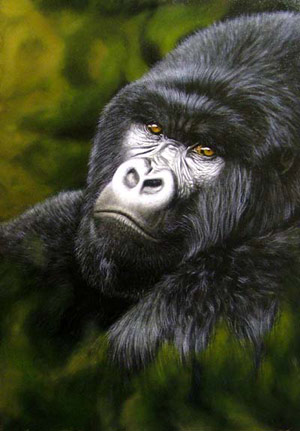
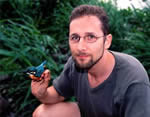
Hi love the video on the gorilla. I am new at this painting buisness. I am teaching myself. I would like to know if the Liquin comes in a bottle and is it a drying ajent? Also when you say glaze is that some thing that comes in a bottle or is it some thing that you mix? You do such a great job.
Amazing. Love the detail!
Hi,
Yes Liquin comes in a bottle, made by Winsor & Newton, you can get it from all art stores.
More details onmy site http://www.jasonmorgan.co.uk
All the best
jason